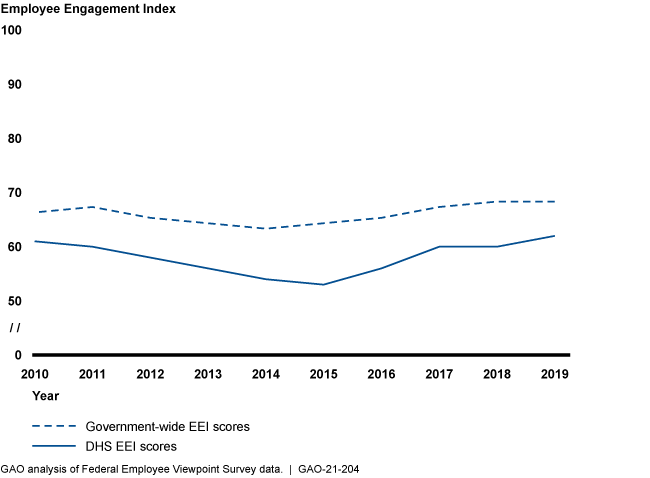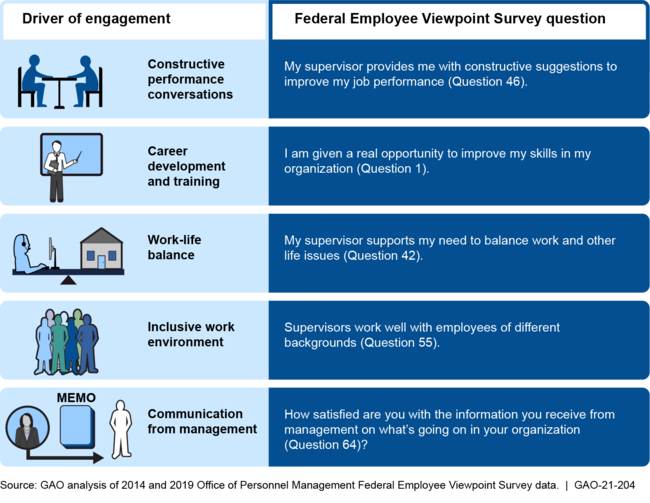DHS Employee Morale: Some Improvements Made, but Additional Actions Needed to Strengthen Employee Engagement
Fast Facts
The Department of Homeland Security has had low employee morale and low employee engagement—an employee's sense of purpose and commitment—since it began operations in 2003. Greater employee engagement results in better performance, studies show.
DHS made some progress improving engagement from 2015-2019. However, as of 2019, a federal survey shows that DHS continues to rank lower in engagement than the government-wide average.
We found that holding constructive performance conversations was the strongest driver of employee engagement across DHS.
We recommended ways to improve DHS's efforts to increase employee engagement and more.
Department of Homeland Security Employee Engagement Index Scores Have Been Lower Than Government-wide Scores

Highlights
What GAO Found
The Department of Homeland Security (DHS) and each of its major components face the same key drivers of employee engagement—as measured by the Office of Personnel Management's Federal Employee Viewpoint Survey (OPM FEVS)—as the rest of the federal government (see table). Higher scores on the OPM FEVS indicate that an agency has the conditions that lead to higher employee engagement, a component of morale.
Key Drivers of Employee Engagement across the Federal Government, the Department of Homeland Security (DHS), and within Each DHS Component Agency

DHS has implemented department-wide employee engagement initiatives, including efforts to support DHS employees and their families. Additionally, DHS's major operational components, such as U.S. Customs and Border Protection and the Transportation Security Administration, among others, have developed annual action plans to improve employee engagement. However, DHS has not issued written guidance on action planning and components do not consistently include key elements in their plans, such as outcome-based performance measures. Establishing required action plan elements through written guidance and monitoring the components to ensure they use measures to assess the results of their actions to adjust, reprioritize, and identify new actions to improve employee engagement would better position DHS to make additional gains in this area. In addition, approval from the DHS Office of the Chief Human Capital Officer (OCHCO) and component leadership for these plans would help ensure department-wide commitment to improving employee engagement.
Why GAO Did This Study
DHS has faced challenges with low employee morale and engagement—an employee's sense of purpose and commitment—since it began operations in 2003. DHS has made some progress in this area, but data from the 2019 OPM FEVS show that DHS continues to rank lowest among similarly-sized federal agencies. GAO has reported that increasing employee engagement can lead to improved agency performance, and it is critical that DHS do so given the importance of its missions.
GAO was asked to review DHS employee morale. This report addresses (1) drivers of employee engagement at DHS and (2) the extent that DHS has initiatives to improve employee engagement and ensures effective engagement action planning. To answer these objectives, GAO used regression analyses of 2019 OPM FEVS data to identify the key drivers of engagement at DHS. GAO also reviewed component employee engagement action plans and met with officials from DHS and component human capital offices as well as unions and employee groups.
Recommendations
GAO is making three recommendations. DHS OCHCO should, in its anticipated written guidance, establish the elements required in employee engagement action plans and the approval process for these plans. OCHCO should also monitor components' action planning to ensure they review and assess the results of their actions to improve employee engagement. DHS concurred with GAO's recommendations.
Recommendations for Executive Action
| Agency Affected | Recommendation | Status |
|---|---|---|
| Department of Homeland Security | DHS OCHCO should, through its planned written guidance to components on the employee engagement action planning process, establish the elements required in component engagement action plans, including leveraging information such as their key drivers to identify root causes, setting output-based implementation targets, and setting goals through outcome-based performance measures. (Recommendation 1) |
We found that as of November 2020, the DHS Office of the Chief Human Capital Officer (OCHCO) had not provided components with written guidance on steps the components should take to develop and document their employee engagement action plans that they submit to OCHCO for review. As a result, we recommended that DHS OCHCO should, through written guidance to components on the employee engagement action planning process, establish the elements required in component engagement action plans, including leveraging information such as their key drivers to identify root causes, setting output-based implementation targets, and setting goals through outcome-based performance measures. In response, in March 2021, OCHCO issued written guidance for the DHS component employee engagement action planning process that required these elements. As a result, DHS is better positioned to ensure that the components develop action plans that include the root causes of engagement challenges, set output-based implementation targets, and set goals through outcome-based performance measures. This written guidance will also enable components to better plan and prioritize engagement efforts and establish frameworks to monitor progress toward the goals set in the plans.
|
| Department of Homeland Security | DHS OCHCO should, through its planned written guidance to components on the employee engagement action planning process, require the approval of OCHCO and the heads of the components to finalize the employee engagement action plans. (Recommendation 2) |
In March 2021, OCHCO issued written guidance for the DHS component employee engagement action planning process. This guidance requires signature from either the component head or deputy component head on the component's employee engagement action plan. This guidance also establishes a process for OCHCO to review and provide an assessment of the component employee engagement action plans. As part of this process OCHCO may approve, approve with reservations, or not approve the employee engagement action plan. Components may then revise their plan based on OCHCO's assessments to obtain plan approval, but are not required to take this step under the March 2021 guidance. For the 2021 action planning cycle, not all components fully incorporated OCHCO's feedback to ensure their employee engagement action plans addressed the key areas identified in our report. As a result, OCHCO assessed some components' final plans at the level of "approved with reservations." For the 2023 action planning cycle, one component-U.S. Immigration and Customs Enforcement-again prepared a plan that OCHCO assessed as "approved with reservations." DHS OCHCO's review process provides components with comprehensive and important feedback on the content of their plans to ensure they meet key expectations for such plans. OCHCO anticipates that components will finalize their 2025 action plans in August 2025. To address the intent of our recommendations, all components must prepare plans that conform with OCHCO's expectations and obtain OCHCO approval, without reservations.
|
| Department of Homeland Security |
Priority Rec.
DHS OCHCO should monitor components' implementation of the OPM action planning cycle to ensure the components review and assess the results of their actions to adjust, reprioritize, and identify new actions needed to improve employee engagement. (Recommendation 3) |
In March 2021, OCHCO issued written guidance that includes mechanisms to monitor components implementation of the OPM action planning cycle. Overall, DHS components have made progress responding to OCHCO's written assessment of components' plans. OCHCO's assessments help ensure components monitor and document the results of their employee engagement action planning efforts. However, for the 2023 action planning cycle, DHS OCHCO continued to assess the U.S. Immigration and Customs Enforcement plan at the level of "approved with reservations," partly because the plan lacked information about tracking and documenting results over time. (Two other components' plans lacked information about tracking and documenting results over time, in part because their 2021 plans had deficiencies in metrics and were therefore "approved with reservations." These two components improved their plans in 2023 in response to OCHCO's 2021 assessment and are, therefore, better positioned to track and document results over time.) OCHCO anticipates that components will finalize their 2025 action plans in August 2025. To fully address this recommendation, all components must review and assess the results of their actions to adjust, reprioritize, and identify new actions needed to improve employee engagement.
|
